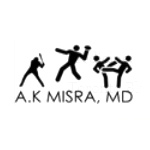Health Tips brought to you by U.S. HealthWorks Medical Group. Our experienced medical experts provide information here that we hope will broaden your health care knowledge.
Today we talk to Dr. A.K. Misra, medical director for U.S. HealthWorks in South San Francisco, about pain medications and the risk of abusing them or developing reliance on them. Dr. Misra is double board certified in Sports Medicine and Internal Medicine.
Q: There is a lot of focus on pain medications in the media and news. Can you explain why all the attention and what we should know regarding this?
A: It is true there is a new and more intense focus on this matter. Unfortunately, in recent years, the number of deaths from prescription opioid-based medications (narcotics) has exceeded the deaths from illicit or illegal narcotics.
This has spurred a debate in government and the medical industry on how to address the problem, ranging from monitoring to education to rehabilitation. For example, the state government in California monitors all medications prescribed through this centralized website called CURES.
As a licensed physician in the state of Florida, too, I learned about some of the most egregious cases of irregular prescribing practices that took place mostly in south Florida. The term “pill mills” were often used to reference offending clinics and medical centers, and they were the center of much media attention locally and nationally with U.S. Drug Enforcement Administration (DEA) raids.
The American Medical Association (AMA) is making a major effort to focus on this topic, and has shared two recent media stories that shed light on the epidemic of opioid abuse and the issues surrounding pain medication. AMA also has information about preventing opioid abuse on its website.
Q: What are some of the signs to be mindful or careful of while taking pain medications?
A: When physicians prescribe these extremely serious medications, the directions are usually explicit in that a certain number of medications are limited within a particular period of time (e.g. three or four pills a day on an as-needed basis).
If you find yourself believing you need to take more than the recommended amount for whatever reason – inadequate pain control, the sense of addiction or any other reason – it is crucial not to do that, and to seek direction from the prescribing doctor (or another qualified physician) of the medication immediately. Patients should never take more of this type of medication than recommended by the prescribing physician. Certainly any sort of withdrawal-like symptoms (agitation, anxiety, increased tearing, and/or insomnia) would also need to be brought to the immediate attention of a physician as well.
One of the most common signs of opioid overdose is constipation. Opioid-based medications (narcotics) are well-known to slow down the gastrointestinal tract, which is why they are often prescribed with what is termed a “bowel regimen” to prevent constipation. Other danger signs of overdose include pinpoint pupils, decreased level of consciousness, and a decreased respiratory and heart rate from one’s baseline.
Q: What are some resources that may be useful to both patients and physicians?
A: There is an abundance of information available online, however, Choosing Wisely, an initiative of the ABIM Foundation, recently recommended the following sources from Consumer Reports.
Medicines to Relieve Chronic Pain: When you need opioids (narcotics) — and when you don’t
Treating Frequent Headaches with Pain Relievers: When you need them — and when you don’t
Treating Migraine Headaches: Some drugs should rarely be used
Due to the complex nature of pain medications, U.S. HealthWorks defers to the expertise of specialists in these disciplines (pain management, addiction medicine) for direction and as a rule does not prescribe pain medications or keep any in stock.
Q: All this seems rather daunting. Are there other ways to manage pain apart from medications?
A: Yes, in fact we like to think of medications as a last resort not just for pain, but for any problem. Some emergency rooms have even set up acupuncture services to help people deal with acute pain. Yoga, acupressure, and acupuncture are all quite useful for many conditions ranging from chronic pain to headaches and other types of problems.
Further, depending on the type of pain (such as nerve, disc or muscular), the first line of treatment may not always be medications. This will take a cultural shift in the expectations of patients who seek a simple answer (such as a pill) for complex problems such as pain, as well as physicians doing their best to minimize medications of all sorts – but especially these types of pain medications. I am pleased to see renewed focus on finding other ways to manage pain, and patients should always seek direction from their physicians on all options available to them to care for and manage pain.






